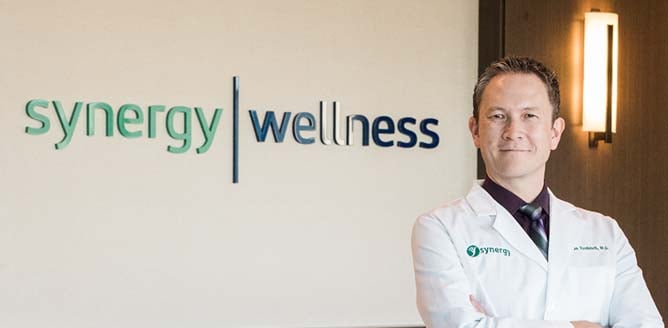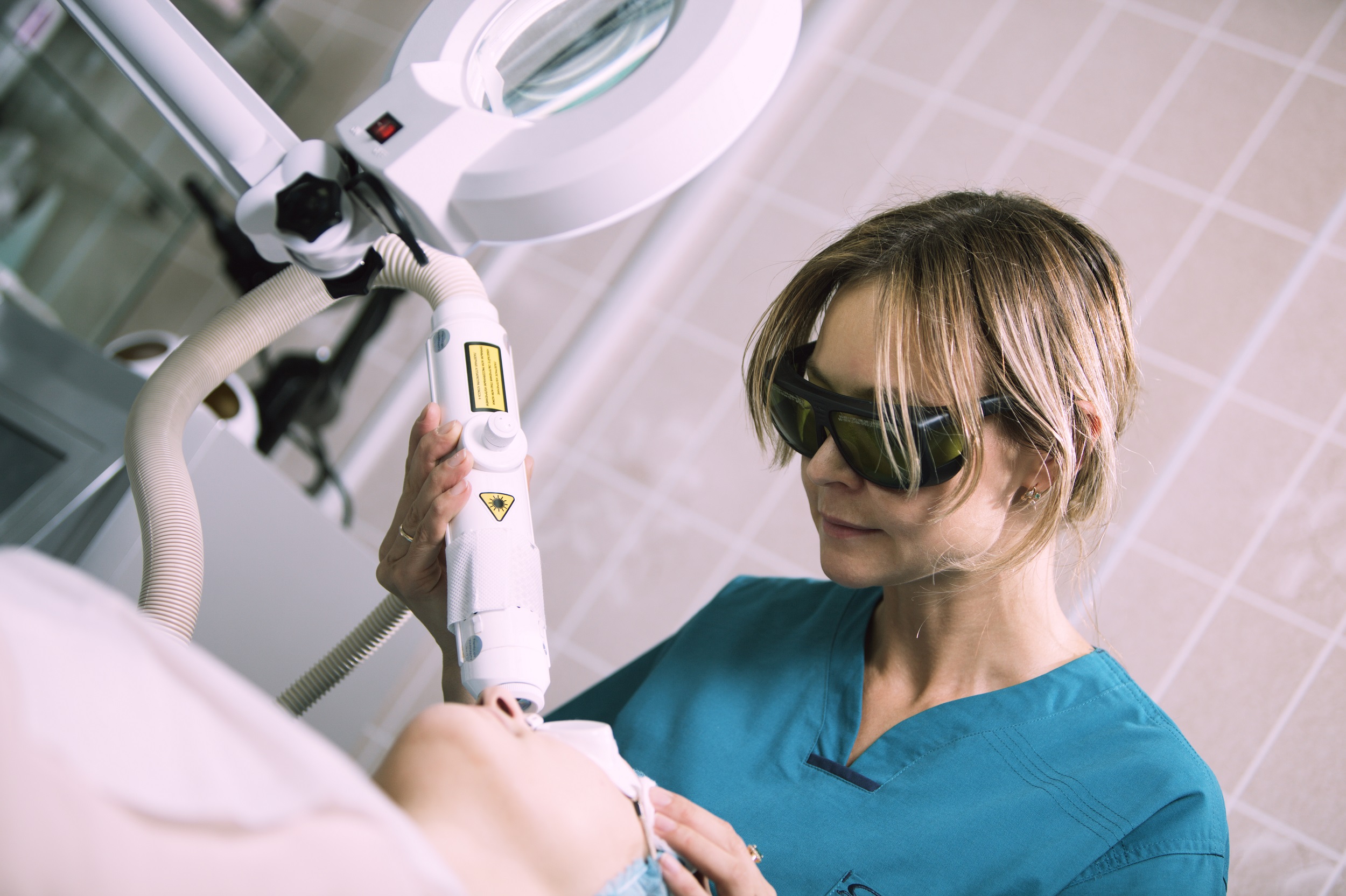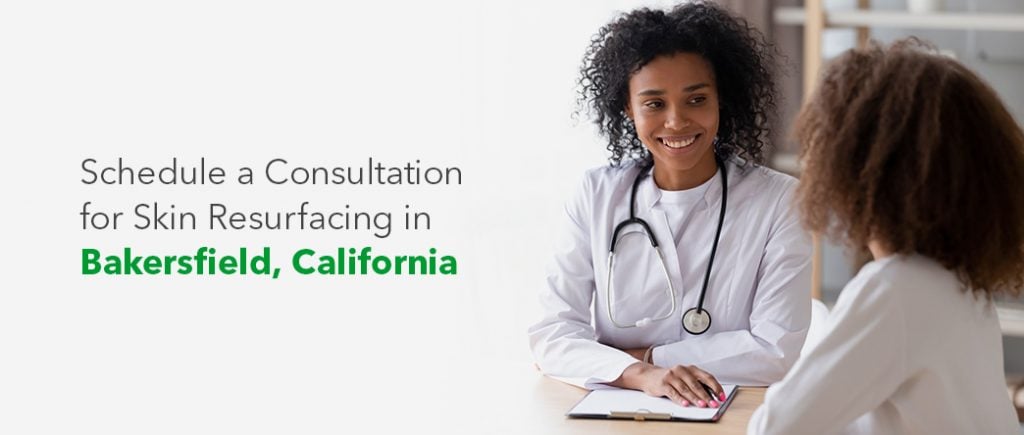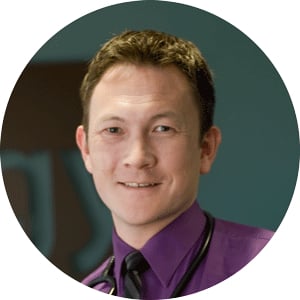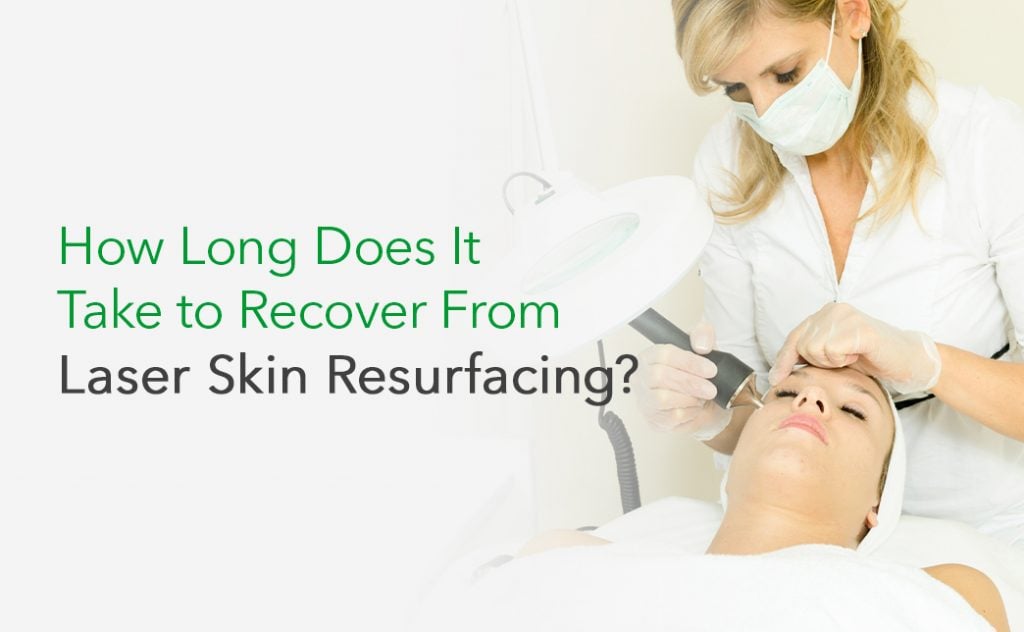
Are you thinking about laser therapy but aren’t sure it fits into your schedule? Laser skin resurfacing can give you radiant, younger-looking skin with long-lasting results. But as with most medical procedures, it typically requires some downtime. The good news is, facial laser treatments usually do not involve a lengthy recovery, and in some cases, patients heal in less than a week.
Let’s looks at how laser rejuvenation works and what to expect with recovery, so you can determine if it’s right for you.
Contact Us for Skin Resurfacing Treatment
How Does Laser Resurfacing Work?
Laser resurfacing is a high-precision skin rejuvenation procedure used to diminish blemishes, wrinkles, lesions and scars. During the process, a medical professional applies a concentrated beam of light to the target area. The laser beam stimulates collagen growth, leading to tighter, smoother and more youthful-looking skin.
There are two types of lasers used to perform skin resurfacing — ablative and nonablative lasers. Your dermatologist will recommend an ablative or nonablative laser, depending on your wants and needs. Here’s how they differ:
Ablative Lasers
Ablative lasers eliminate the unwanted outer skin called the epidermis by precisely vaporizing each layer. The laser simultaneously heats the dermis, which is the deeper skin layer, stimulating cell growth. The process causes new skin to form as the epidermis heals.
Ablative laser resurfacing is an effective technique for improving sun-damaged or aged skin. Your dermatologist might recommend this form of laser therapy to improve the appearance of deep wrinkles and scars.
Nonablative Lasers
Nonablative lasers stimulate cell growth without removing skin layers. Your doctor might recommend this method to treat spider veins, fine wrinkles and rosacea. Since nonablative laser resurfacing does not involve vaporizing skin layers, it typically produces less dramatic results than ablative procedures but entails a faster recovery.
What Skin Conditions Can Laser Skin Resurfacing Treat?

Laser rejuvenation is primarily used to treat common blemishes and reduce the appearance of aging, enhancing the patient’s natural beauty and boosting their self-confidence. You might consider laser resurfacing to improve any of the following:
- Sagging skin: People commonly experience sagging skin in the lower face and neck as they get older and collagen and elastin production slow down. You might also have loose skin in the lower face if you’ve lost weight. Laser resurfacing is a nonsurgical way to tighten loose skin and create a more youthful appearance by stimulating collagen production. According to the American Academy of Dermatology (AAD), laser resurfacing is the most effective method for tightening saggy skin.
- Wrinkles: Like sagging skin, wrinkles are a normal side effect of aging. Over time, a person’s skin naturally dries out and loses fat layers, diminishing the smooth surface. Some factors, like sun exposure and cigarette smoking, can make wrinkles develop even faster. Laser resurfacing can treat the fine lines around the eyes and mouth in addition to the deeper wrinkles that form over the years.
- Scars: Many different factors can lead to facial scars, including acne, chickenpox, burns, surgery and injuries. Ablative laser resurfacing can treat facial scars by “peeling” away the damaged top layer of skin and allowing new, healthy skin to form.
- Age spots: Age spots are small discolored areas on the skin. They’re usually flat and brown, and they often appear in clusters. Age spots are common on parts of the body that get the most sun exposure, such as the shoulders, back and face. Many people over 50 have age spots due to sun exposure, but younger people can have them too if they get too much sun at once. Laser resurfacing is a way to remove age spots quickly and effectively.
Is Laser Resurfacing Right for You?
If you have skin blemishes you’d like to see disappear, you probably can’t wait to undergo laser resurfacing. While this treatment can be an exciting step toward a new you, it’s essential to consider if you’re a good match for the procedure first.
Are you healthy and have light to medium-dark skin? If so, you may be an excellent candidate for laser skin resurfacing. A medical professional will need to evaluate you before scheduling the procedure to ensure you get the results you want.
You may not be the best candidate for laser resurfacing if you’re experiencing active acne or have very dark skin. Individuals with dark skin have a higher risk of hypopigmentation or hyperpigmentation, permanently changing the skin color. If you have dark skin, consider an advanced microneedling treatment like Morpheus8, a gentle, low-risk alternative that produces beautiful results.
Your doctor might also advise against laser resurfacing if you:
- Take certain medications
- Have a weak immune system
- Tend to form scars
If you qualify for skin resurfacing, it’s still essential to discuss your expectations and risks with a professional beforehand. You’ll enjoy a more satisfying experience and optimal results when you know what to expect and how to prepare for the treatment.
How to Prepare for Laser Resurfacing
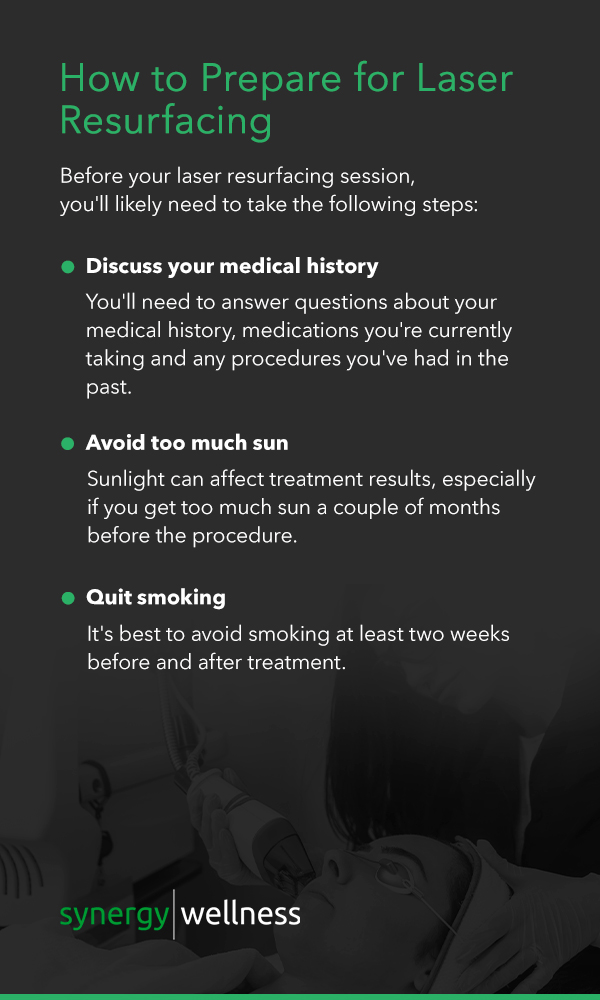
Before your laser resurfacing session, you’ll likely need to take the following steps:
- Discuss your medical history: You’ll need to answer questions about your medical history, medications you’re currently taking and any procedures you’ve had in the past. Make sure to tell your dermatologist or aesthetician if you experience cold sores around the mouth because the procedure can trigger a breakout.
- Avoid too much sun: Sunlight can affect treatment results, especially if you get too much sun a couple of months before the procedure. Ask your dermatologist or aesthetician how much sunlight is safe and find out what you should do to protect yourself. You’ll also want to avoid tanning a month before your treatment.
- Quit smoking: It’s best to avoid smoking at least two weeks before and after treatment. Quitting smoking will help your skin recover faster and reduce the chance of side effects.
What to Expect During Laser Resurfacing Treatment
Laser resurfacing is generally a quick procedure performed in a doctor’s office or medical spa. Before treatment, a medical professional will apply a local anesthetic to the area to keep you from feeling discomfort. If you’re treating a large area, like your back, your doctor might recommend general anesthesia.
After preparing your skin with an anesthetic, the dermatologist or aesthetician will carefully move a laser around the target area. When they’re done, they’ll wrap the area with a dressing material to protect your skin.
Here’s what else you’ll want to know:
How Long a Session Usually Takes
A laser resurfacing session typically takes about 30 to 45 minutes, but this also depends on the size of the area being treated. For example, if you’re receiving full-face treatment with an ablative laser, you can expect the session to last up to 2 hours. A partial-face treatment is faster and generally takes less than an hour.
Side Effects of Laser Treatment
When a qualified medical professional performs laser resurfacing, it’s a safe and effective treatment method for damaged or discolored skin. Still, as with most medical procedures, laser resurfacing can cause side effects. Side effects of ablative laser resurfacing may include:
- Irritation: Laser resurfacing might cause the treated area to become itchy, swollen and red. You’re more likely to experience post-procedure irritation if the treatment triggers a skin condition like rosacea.
- Skin color changes: You might experience pigment changes from the treatment. As mentioned earlier, your risk of skin color changes increases if you have dark skin.
- Scarring: There’s a slight chance that laser resurfacing will cause a scar in the treated area.
- Ectropion: Ectropion is when the lower eyelid droops. This is a rare side effect of laser resurfacing that could happen if you treat the area near the lower eyelid.
- Acne: Since after-care requires you to wear a dressing, you might experience a breakout if you’re prone to acne.
Nonablative laser resurfacing may also cause a few side effects, such as:
- Skin color changes: You might experience darker skin temporarily in the treated area.
- Cold sores: If you have the herpes virus, nonablative laser resurfacing may trigger a cold sore outbreak.
- Mild irritation: Nonablative laser resurfacing can cause mild redness and swelling.
When You’ll See Results
You will see the results from laser skin resurfacing once you heal and new skin has formed. With that said, the type of treatment you receive impacts how quickly you’ll notice an improved appearance.
For example, according to the AAD, laser resurfacing produces the fastest results for tightening sagging skin. You can expect to see tighter skin and fewer wrinkles within two weeks after you heal from the treatment. For several months after the procedure, you’ll notice improvements as your body produces new collagen.
If you’re treating pigmentation, like age spots, you can expect immediate results. The pigment will continue to improve for months after the procedure.
Types of Laser Skin Resurfacing and Their Recovery Times

The amount of time it takes to recover from laser resurfacing depends on the type of laser your doctor uses and how your body reacts to the treatment. Usually, nonablative lasers do not have any downtime, while ablative lasers might require three weeks to heal fully. As you recover from laser resurfacing, the treated area may be swollen and red.
Here are the different types of laser facial treatments and their typical recovery times:
Erbium Laser Resurfacing
Erbium lasers can be ablative or nonablative. Your doctor might recommend erbium laser resurfacing if you wish to treat mild to moderate wrinkles or age spots or if you have darker skin. Erbium lasers generally cause few side effects and involve a fast recovery time. You can usually expect to be healed from erbium laser resurfacing a week after the treatment.
Fractional Laser Resurfacing
Like erbium lasers, fractional lasers may be ablative or nonablative. Fractional lasers apply thousands of small lights beams to one skin portion at a time. You can expect to recover from fractional laser resurfacing in about a week or two.
CO2 Laser Resurfacing
Carbon dioxide (CO2) lasers are usually a type of ablative laser. Medical professionals use CO2 lasers to precisely remove skin layers and treat deep wrinkles, scars, warts and other blemishes. The laser resurfacing recovery time for CO2 treatments is about two weeks.
Pulsed Dye Laser Resurfacing
Pulsed dye lasers (PDLs) are usually nonablative. With PDL resurfacing, the laser targets the skin’s blood vessels and uses heat to destroy them. This reduces rosacea, broken capillaries and hyperpigmentation. PDL resurfacing usually involves minimal side effects and fast recovery. You can expect to heal from PDL treatment in less than two weeks.
Tips for Skin Resurfacing Recovery
During the first few days of your recovery, the treated area may be red, swollen and itchy. The old skin will also peel away about a week after your treatment. You’ll want to follow your doctor’s instructions carefully after laser resurfacing to prevent infection and promote healing. The faster you heal, the sooner you’ll see the results!
Here are some general tips to help you feel better after your treatment:
- Avoid makeup, lotion or other products that could irritate your skin as you heal.
- Apply a cool compress to reduce discomfort and swelling.
- Avoid activities that increase the risk of infection as you recover, like swimming.
- Use the sunscreen your doctor recommends and minimize sun exposure.
- Avoid scratching or touching the treated skin until you heal.
- Stay hydrated to help your body recover faster.
Will You Need Follow-up Treatments for Laser Resurfacing?
You may or may not need follow-up sessions depending on the treatment you received. For example, if you receive nonablative laser treatment, your doctor may recommend follow-up treatments for the best results. Nonablative laser treatments are usually performed in multiple sessions over several weeks. On the other hand, ablative laser resurfacing might produce the results you want in a single session.
Your needs also determine whether you’ll require follow-up treatments. If you have a minor concern, like fine lines, you may only need one laser resurfacing treatment. The results from treating a minor concern could last seven years or longer.
If you require more intense treatment, you might consider yearly or monthly laser resurfacing. Your dermatologist or aesthetician can help you determine a routine that produces the results you’re hoping for.
Schedule a Consultation for Skin Resurfacing in Bakersfield, California
Laser resurfacing is just one method for rejuvenating your skin and getting back that youthful glow. For anti-aging treatment that’s quick, non-invasive and requires minimal downtime, ask us about Morpheus8, one of the most advanced skin resurfacing procedures. Morpheus8 combines microneedles and radiofrequency to reach deep into your skin and stimulate collagen and elastin production. The result is tighter, smoother, more radiant skin — and a short laser facial recovery.
Ready to reduce the effects of aging and endless California sunshine? Contact our medical aesthetic clinic today to schedule your consultation or learn more about our cosmetic services.

